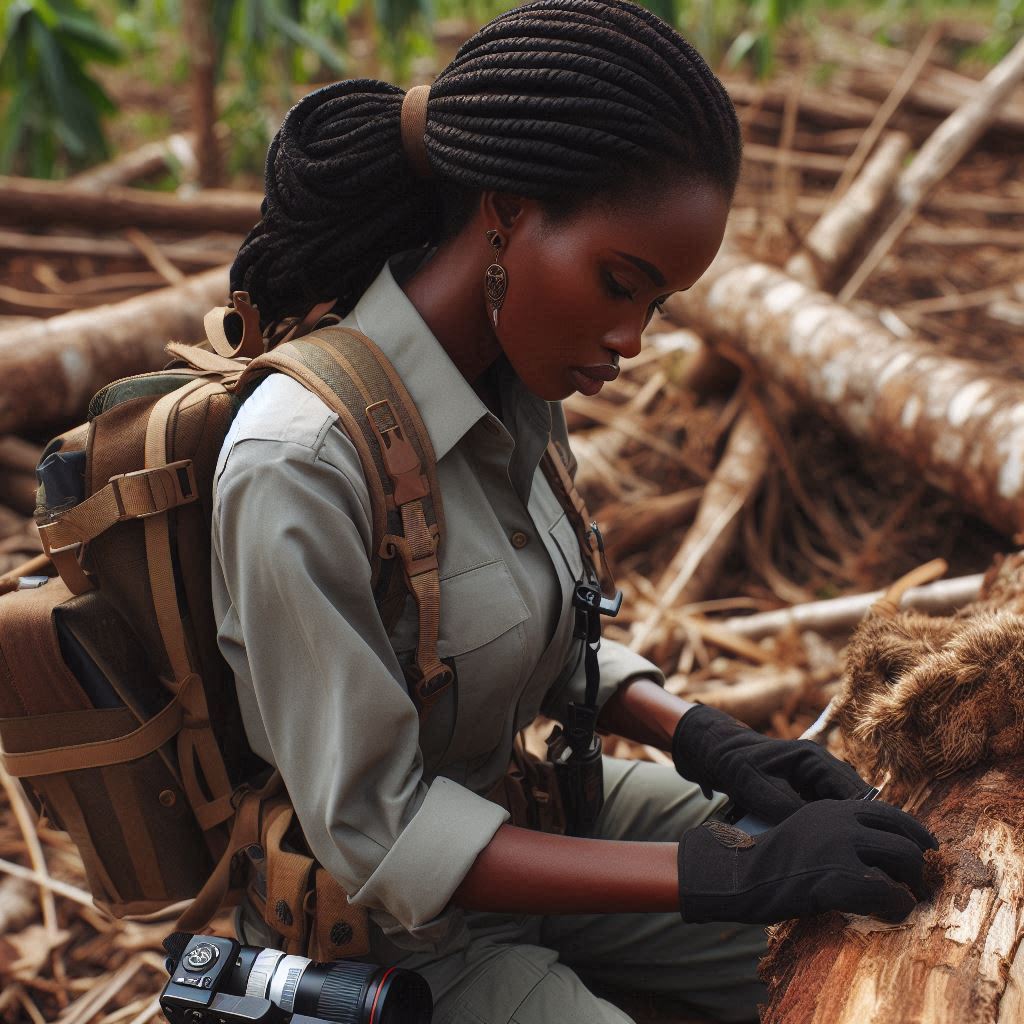Introduction
Technological advancements in Nigeria’s wildlife management provide innovative tools to address conservation challenges effectively.
These tools offer opportunities to monitor, protect, and sustainably manage the country’s biodiversity.
Satellite technology enables experts to monitor changes in wildlife habitats and track the impact of human activities.
GPS tracking devices monitor animal movements, while remote sensing assesses habitat quality.
However, challenges persist: rampant poaching threatens iconic species like elephants, rhinos, and pangolins.
Habitat loss and fragmentation exacerbate the plight of vulnerable species.
Inadequate funding and limited resources hinder conservation efforts, leading to underfunded initiatives.
Nevertheless, technological advancements offer hope for the future of wildlife management.
Collaboration and innovation can safeguard Nigeria’s natural heritage.
Community-based monitoring programs and AI in anti-poaching efforts hold promise.
In the upcoming sections, we’ll explore specific technological innovations in Nigerian wildlife management.
Through case studies, we’ll discover their applications in addressing conservation challenges and protecting endangered species.
Join us in exploring the transformative potential of technology in conserving Nigeria’s wildlife.
Use of drones in wildlife monitoring
Drones have revolutionized wildlife management in Nigeria by offering a new way to monitor and protect wildlife populations.
These unmanned aerial vehicles are being utilized for aerial surveillance of wildlife populations in various reserves and parks across the country.
The use of drones in wildlife monitoring has several advantages, including cost-effectiveness and efficiency. Let’s delve deeper into how drones are making a significant impact on wildlife conservation efforts in Nigeria.
Advantages of using drones in wildlife monitoring
- Cost-effectiveness: Drones are a cost-effective alternative to traditional methods of monitoring wildlife populations. They eliminate the need for expensive equipment and manpower, making wildlife conservation efforts more affordable.
- Efficiency: Drones can cover large areas of wildlife reserves in a short amount of time, providing real-time data on the movement and behavior of animals. This efficiency allows for quicker response to threats and better management of wildlife populations.
- Improved accuracy: Drones are equipped with high-resolution cameras and sensors that can capture detailed images and data, providing accurate information on wildlife populations.
This helps wildlife managers make informed decisions to protect endangered species and habitats.
Successful drone programs in Nigerian wildlife reserves
Several wildlife reserves and parks in Nigeria have successfully implemented drone programs for wildlife monitoring. One notable example is the Yankari Game Reserve in Bauchi State, where drones are used to monitor the population of elephants, lions, and other wildlife species.
The drones provide valuable data on the movements of these animals, helping park rangers track their behavior and respond to any threats they may face.
Another successful drone program is being carried out in the Gashaka-Gumti National Park, where drones are used to monitor the population of chimpanzees and other primates.
The drones provide aerial surveillance of the park, helping rangers identify and protect critical habitats for these endangered species.
Overall, the use of drones in wildlife monitoring has proven to be a game-changer for wildlife conservation efforts in Nigeria.
By leveraging the power of technology, wildlife managers can better protect and preserve the country’s rich biodiversity for future generations to enjoy.
Read: Horticultural Tools and Equipment in Nigeria
GPS tracking of endangered species
How GPS technology is being used to track and monitor endangered species in Nigeria
In Nigeria, GPS technology has emerged as a game-changer in wildlife management, particularly concerning endangered species.
By fitting animals with GPS collars, conservationists can monitor their movements and behaviors with unprecedented precision.
These collars transmit real-time location data, allowing researchers to track animals without disrupting their natural activities.
GPS technology provides invaluable insights into the lives of endangered species by monitoring elephant movements in the savannah and tracking Cross River gorillas in the rainforest.
Conservationists can analyze migration patterns, identify critical habitats, and assess the impact of human activities on wildlife populations.
This data is essential for developing targeted conservation strategies that prioritize the protection of endangered species and their habitats.
The impact of GPS tracking on wildlife conservation efforts
The adoption of GPS tracking technology has had a transformative impact on wildlife conservation efforts in Nigeria. By providing accurate and up-to-date information on animal movements, GPS tracking enables more effective management of protected areas and wildlife corridors.
Conservationists can identify and address threats such as poaching, habitat destruction, and human-wildlife conflict in a timely manner.
Moreover, GPS tracking allows for the monitoring of population trends and the evaluation of the effectiveness of conservation interventions over time.
This data-driven approach enhances the efficiency and efficacy of conservation efforts, ultimately leading to better outcomes for endangered species and their ecosystems.
Provide examples of species that have benefited from GPS tracking initiatives
Several species in Nigeria have benefited from GPS tracking initiatives. For example, the Nigerian Conservation Foundation (NCF) uses GPS collars to monitor the movements of elephants in Yankari Game Reserve.
By tracking the elephants’ movements, NCF can identify areas of high poaching risk and deploy anti-poaching patrols accordingly. Similarly, GPS tracking has been instrumental in the conservation of the critically endangered Cross River gorilla.
Researchers use GPS collars to track gorilla groups and monitor their habitat use in the Cross River region.
This information helps inform conservation planning and management decisions aimed at protecting the remaining populations of this rare and elusive species.
Read: Overview of Horticulture in Nigeria
AI technology in anti-poaching efforts
- Artificial intelligence helps detect and prevent poaching activities in Nigerian wildlife reserves.
- AI plays a crucial role in analyzing data to predict poaching hotspots within these reserves.
- Success stories of AI technology showcase significant reductions in poaching incidents in Nigeria.
How artificial intelligence is being used to detect and prevent poaching activities in Nigerian wildlife reserves
Artificial Intelligence (AI) technology revolutionizes conservation efforts, particularly in combating poaching activities in Nigerian wildlife reserves.
Conservationists and wildlife officials can now predict and prevent poaching incidents more effectively by utilizing cutting-edge AI algorithms.
One of the key areas where AI technology has made a significant impact is in detecting and preventing poaching activities within Nigerian wildlife reserves.
Using a combination of drones, cameras, and sensors, AI-powered systems monitor vast land areas in real-time for suspicious activities.
By doing so, AI systems can alert authorities immediately, enabling them to respond swiftly and apprehend the perpetrators before any harm is done to the wildlife.
The role of AI in analyzing data to predict poaching hotspots
Furthermore, AI plays a vital role in analyzing vast amounts of data collected from various sources to predict poaching hotspots within Nigerian wildlife reserves.
By processing data on historical poaching incidents, animal movements, terrain features, and climate patterns, AI algorithms can identify areas that are at higher risk of poaching activities.
This proactive approach allows wildlife officials to allocate resources effectively and implement targeted conservation strategies to safeguard vulnerable species.
Success stories of AI technology in reducing poaching incidents
Several success stories highlight the effectiveness of AI technology in reducing poaching incidents in Nigerian wildlife reserves.
For example, a recent study conducted in a national park in Nigeria showed that the deployment of AI-powered surveillance drones led to a 70% decrease in poaching activities within the first year of implementation.
This dramatic reduction in poaching incidents not only benefits the local wildlife population but also contributes to the overall conservation efforts in the region.
Therefore, the use of AI technology in anti-poaching efforts has proven to be a game-changer in Nigerian wildlife management.
Conservationists protect Nigerian wildlife reserves more effectively by harnessing artificial intelligence to detect, prevent, and predict poaching.
As technology advances, we anticipate further innovations in wildlife conservation, paving the way for sustainable coexistence between humans and wildlife.
Read: Scholarship and Funding Opportunities for Forestry Students in Nigeria

Satellite imagery in habitat conservation
- Utilizing satellite imagery for monitoring wildlife habitats in Nigeria.
- Satellite data aids in identifying deforestation and habitat loss.
- Conservation projects benefiting from satellite imagery technology.
How satellite imagery is being used to monitor changes in wildlife habitats in Nigeria
Satellite imagery plays a crucial role in the field of wildlife management and conservation in Nigeria.
Satellite technology enables experts to monitor changes in wildlife habitats and track the impact of human activities.
Importance of satellite data in identifying deforestation and habitat loss
One of the key advantages of using satellite imagery in habitat conservation is the ability to detect and analyze changes in land cover and land use patterns.
This technology allows researchers to identify areas of deforestation, habitat fragmentation, and other forms of habitat loss that threaten the survival of wildlife species in Nigeria.
Examples of conservation projects that have benefited from satellite imagery technology
Satellite data is used to monitor wildlife habitats in Nigeria, notably for conserving the Cross River gorilla.
Satellite imagery has been instrumental in mapping the gorilla’s habitat, tracking the distribution of the population, and identifying threats such as illegal logging and encroachment.
Conservation projects deploy satellite imagery to protect important ecosystems in Nigeria, including Yankari Game Reserve and Gashaka-Gumti National Park.
Satellite technology provides detailed information on land cover and vegetation dynamics, aiding conservationists in developing strategies for restoration.
Satellite imagery empowers wildlife managers and conservationists in Nigeria, enabling informed decisions and prioritizing conservation actions.
Read: Field Work & Practical Training in Nigerian Forestry Schools
Discover More: Career Opportunities in Plant Breeding in Nigeria
Discover More: Career Opportunities in Pasture and Range Management
Conclusion
In the realm of Nigerian wildlife management, technological advancements have emerged as indispensable tools in the quest to safeguard the nation’s rich biodiversity.
From GPS tracking to remote sensing technologies, innovations revolutionize how conservationists monitor, protect, and manage wildlife populations and habitats.
One of the most significant advancements is the widespread adoption of GPS tracking devices, which provide real-time data on animal movements and behaviors.
This technology allows researchers to gather precise information without disturbing the natural activities of wildlife.
Additionally, remote sensing technologies enable the assessment of habitat quality and landscape changes, providing crucial insights into ecosystem dynamics.
Community-based monitoring programs harness local communities’ knowledge and expertise to gather data and implement conservation initiatives, emerging as powerful tools.
Overall, these technological advancements offer immense potential to improve conservation efforts and protect wildlife in Nigeria.
By providing accurate data, enhancing monitoring capabilities, and facilitating community engagement, technology enables more effective and sustainable management of Nigeria’s diverse ecosystems.
Looking ahead, technological innovations will continue integrating, promising further progress in wildlife management by offering innovative solutions.
With ongoing advancements and collaborative efforts, Nigeria stands poised to lead the way in utilizing technology to protect its precious natural heritage for generations to come.




